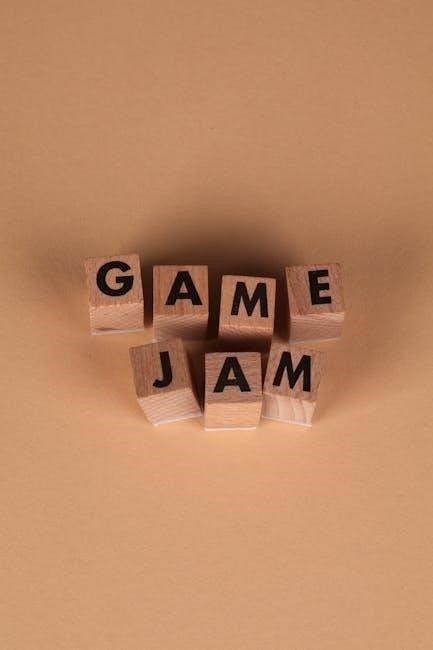Game theory, as outlined in “Theory of Games and Economic Behavior,” provides a mathematical framework for analyzing strategic decision-making, revolutionizing economics and understanding human behavior in competitive scenarios.
1.1. Definition and Scope of Game Theory
Game theory is a mathematical framework used to analyze strategic interactions among rational decision-makers. It provides tools to understand how individuals, firms, or nations make choices that affect others, aiming to predict outcomes and optimize strategies. The scope of game theory spans various disciplines, including economics, political science, and biology. At its core, it examines situations where the outcome depends on the actions of multiple participants, often involving cooperation, conflict, or competition. Key elements include players, strategies, payoffs, and rules. By modeling these interactions, game theory helps uncover patterns and equilibrium points, offering insights into human behavior and decision-making processes.
1.2. Historical Development of Game Theory
Game theory’s historical development began in the 18th century with scholars like James Waldegrave and Jean-Baptiste Cournot, who analyzed simple strategic interactions. The 20th century marked significant progress, with John von Neumann and Oskar Morgenstern laying the mathematical foundations in their 1944 book. The 1950s saw John Nash’s introduction of the Nash Equilibrium, a cornerstone concept. Later, economists like Reinhard Selten and Robert Aumann expanded game theory into sequential and cooperative games. Today, it is a cornerstone of economics, influencing political science, biology, and computer science.
1.3. The Role of Mathematics in Game Theory
Mathematics is the backbone of game theory, providing the tools to analyze strategic interactions and decision-making processes. It relies heavily on concepts like probability, linear algebra, and optimization. Key mathematical frameworks include payoff matrices, which represent outcomes of strategies, and equilibrium concepts, such as Nash Equilibrium. These tools enable precise modeling of competitive and cooperative scenarios. Mathematics also facilitates the derivation of solutions and predictions, making game theory a rigorous scientific discipline. The integration of mathematical methods ensures objectivity and clarity in analyzing complex interactions, allowing economists to draw actionable insights for real-world applications.

The Seminal Work: “Theory of Games and Economic Behavior”
“Theory of Games and Economic Behavior” by John von Neumann and Oskar Morgenstern is a groundbreaking work that laid the foundation for modern game theory. Published in 1944, it introduced rigorous mathematical frameworks to analyze economic decision-making and strategic interactions. The book’s innovative approach integrated psychology, economics, and mathematics, offering a systematic way to understand competitive and cooperative behaviors. Its influence extends beyond economics, shaping fields like political science, sociology, and biology. This seminal work remains a cornerstone of game theory, providing essential insights into human behavior and strategic reasoning.
2.1. Overview of the Book by John von Neumann and Oskar Morgenstern
Published in 1944, “Theory of Games and Economic Behavior” is a seminal work by John von Neumann and Oskar Morgenstern that revolutionized the study of economic decision-making. The book introduces game theory as a mathematical framework for analyzing strategic interactions between rational agents. It explores how individuals and groups make decisions to maximize their utility in competitive and cooperative settings. The authors draw on concepts from economics, mathematics, and psychology to create a comprehensive theory of games. The book is divided into sections that cover the fundamentals of game theory, including zero-sum games, strategic formations, and the concept of equilibrium. It also discusses applications to economics, such as market competition and bargaining. The work is considered foundational for understanding human behavior in strategic situations.
2.2. Key Concepts Introduced in the Book
In “Theory of Games and Economic Behavior”, John von Neumann and Oskar Morgenstern introduced several groundbreaking concepts that shaped modern game theory. One of the most significant is the minimax theorem, which provides a solution for zero-sum games by minimizing potential losses. The book also formalized the concept of utility as a measurable and transferable value, enabling precise mathematical analysis of decision-making. Additionally, the authors explored strategic interactions and the idea that economic behavior is inherently a game-like process. They introduced the distinction between cooperative and non-cooperative games, laying the foundation for understanding how individuals and groups make rational choices in competitive and collaborative environments. These concepts remain central to game theory and its applications in economics and beyond.
2.3. The Legacy and Impact of the Book
“Theory of Games and Economic Behavior” revolutionized economics and beyond, establishing game theory as a foundational framework for understanding strategic decision-making. Its impact extends to political science, biology, and social sciences, influencing scholars like John Nash. The book’s mathematical rigor and innovative concepts, such as utility theory, reshaped economic analysis. It earned von Neumann and Morgenstern widespread acclaim, with von Neumann later awarded the Nobel Prize in Economics. The book remains a cornerstone of game theory, inspiring generations of researchers and practitioners. Its legacy lies in its ability to bridge mathematics and social sciences, providing tools to analyze human behavior in competitive and cooperative settings. Its influence continues to grow, ensuring its relevance in modern economic and strategic studies.

Core Concepts in Game Theory
Game theory explores strategic interactions, rational decision-making, and utility maximization. It examines how players make choices to achieve optimal outcomes in competitive and cooperative scenarios.
3.1. Strategic Interactions and Rational Decision-Making
Strategic interactions refer to situations where decision-makers influence each other’s outcomes, requiring anticipation of others’ actions. Rational decision-making involves optimizing choices based on complete information, aligning with utility maximization. In Theory of Games and Economic Behavior, von Neumann and Morgenstern emphasize that players in a game act strategically, considering all possible moves and counter-strategies. This framework assumes rationality, where individuals make logically consistent decisions to achieve their objectives. The concept is foundational in economics, as it models competitive and cooperative behaviors, enabling predictions about equilibrium outcomes. By analyzing these interactions, the theory provides insights into human behavior, market dynamics, and policy design, forming a cornerstone of modern economic analysis and decision-making processes.

3.2. Nash Equilibrium and Its Significance
Nash Equilibrium, introduced by John Nash, is a fundamental concept in game theory where each player’s strategy is optimal given the strategies of others. In Theory of Games and Economic Behavior, the groundwork for such equilibrium concepts was laid, even though Nash’s formulation came later. It represents a stable state where no player can benefit by unilaterally changing their strategy. This concept is crucial for predicting outcomes in competitive scenarios, offering insights into oligopolistic markets, auctions, and bargaining. Its significance lies in its universality, applicable to economics, politics, and social interactions. Nash Equilibrium has become a cornerstone of modern economic analysis, earning Nash the Nobel Prize in Economics in 1994 for its profound impact on understanding strategic decision-making.
3.3. Cooperative vs. Non-Cooperative Games
Cooperative games involve players who can form binding agreements, share rewards, and coordinate strategies, often leading to mutually beneficial outcomes. In contrast, non-cooperative games focus on individual decision-making, where players act independently to maximize their own payoffs. The distinction is crucial in Theory of Games and Economic Behavior, as it shapes the analytical approaches and solutions. Cooperative games often require mechanisms for enforcing agreements, while non-cooperative games rely on strategic rationality. This dichotomy helps economists model real-world interactions, from business alliances to competitive markets. Understanding both types is essential for analyzing how cooperation and self-interest influence economic behavior and strategic decision-making in various scenarios.

Applications of Game Theory in Economics
Game theory provides frameworks for analyzing strategic interactions in economics, offering insights into decision-making, market competition, and policy design. It helps model behaviors and optimize outcomes.
4.1. Auction Theory and Market Mechanisms
Auction theory, a cornerstone of game theory, analyzes bidding strategies and market mechanisms to allocate resources efficiently. It models how participants act under uncertainty, balancing rivalry and cooperation. Different auction formats, such as English, Dutch, sealed-bid, and Vickrey auctions, are studied to understand bidder behavior and optimize outcomes. Game theory provides tools to design mechanisms that maximize revenue or fairness, ensuring aligned incentives. These insights are vital for economists to craft policies fostering competitive markets and innovation, grounded in the principles laid out in foundational texts like Theory of Games and Economic Behavior. By applying strategic reasoning, auction theory enhances market efficiency and economic decision-making.
4.2. Oligopoly and Competitive Market Structures
Oligopoly and competitive market structures are fundamental concepts in economics, analyzed through the lens of game theory. In oligopolies, a few firms dominate the market, leading to strategic interactions where decisions by one firm significantly impact others. Competitive markets, characterized by many firms, often result in lower prices and innovation. Game theory, as outlined in ‘Theory of Games and Economic Behavior,’ provides tools to model these interactions, predicting outcomes like price wars or collusion. Concepts such as Nash equilibrium help explain how firms reach stable strategies. Understanding these dynamics aids economists in designing policies that promote fair competition, essential for maintaining market efficiency and consumer welfare.
4.3. Public Policy and Regulatory Decisions
Game theory has proven instrumental in shaping public policy and regulatory decisions by providing frameworks to analyze strategic interactions among stakeholders. Policymakers use game-theoretic models to predict outcomes of different regulatory interventions, ensuring informed decision-making. For instance, auction theory, a subset of game theory, guides the design of auctions for spectrum licenses or public resources. Regulatory bodies also employ game theory to enforce competition laws, preventing monopolistic practices. Additionally, it helps in understanding the behavior of firms under different regulatory regimes, enabling policymakers to craft policies that promote market efficiency and consumer welfare. This application underscores the practical relevance of game theory in addressing real-world economic challenges.

Game Theory in Political Science and Social Behavior
Game theory provides insights into political strategies, power dynamics, and social interactions, offering frameworks to analyze cooperation, conflict, and decision-making among individuals and groups in society.
5.1. The Prisoner’s Dilemma and Its Implications
The Prisoner’s Dilemma, a cornerstone of game theory, illustrates how rational decision-making by individuals can lead to suboptimal outcomes for all parties involved. Introduced in Theory of Games and Economic Behavior, it describes a scenario where two suspects are questioned separately by authorities. Each faces incentives to betray the other, even though mutual cooperation yields better collective results. This dilemma highlights the tension between individual rationality and collective rationality, offering profound insights into human behavior, cooperation, and conflict. Its implications extend beyond economics, influencing political science, sociology, and ethics. The Prisoner’s Dilemma remains a pivotal concept in understanding strategic interactions and the challenges of achieving cooperation in competitive environments.
5.2. Cooperation and Defection in Political Discourse
Cooperation and defection in political discourse are central to understanding strategic interactions among actors. Game theory, as outlined in Theory of Games and Economic Behavior, provides a framework to analyze these dynamics. Cooperation often leads to mutually beneficial outcomes, while defection can provide short-term advantages but risk long-term instability. Political scenarios, such as coalition building or international treaties, illustrate how rational actors weigh loyalty against self-interest. The interplay between cooperation and defection shapes policy outcomes, alliances, and public trust. This concept is particularly relevant in explaining phenomena like political bargaining, voting behavior, and the challenges of maintaining collective agreements. It underscores the complexity of balancing individual and collective interests in political decision-making.


5.3. Social Contract Theory and Its Relation to Game Theory

Social Contract Theory explores how individuals form societies by agreeing to rules and governments, balancing individual freedoms with collective security. This aligns with Game Theory, as both examine rational decision-making and strategic interactions. The theory, rooted in the works of Hobbes, Locke, and Rousseau, suggests that societies emerge from mutual consent to avoid chaos. Game Theory’s framework of payoffs and equilibria can model these interactions, showing how cooperation or defection affects societal stability. The concept of a “social contract” mirrors cooperative game theory, where agreements among players yield better outcomes. This connection highlights how Game Theory enriches our understanding of societal structures and the rational underpinnings of collective governance, linking economics and political philosophy.

Behavioral Economics and Game Theory
Behavioral economics integrates psychological insights into economic decision-making, complementing game theory by explaining irrational choices and predicting human behavior in strategic interactions, enhancing predictive models of economic behavior.
6.1. The Intersection of Psychology and Economics
Behavioral economics bridges psychology and economics, challenging traditional assumptions of rational decision-making. It explores how cognitive biases, emotions, and social factors influence economic choices. By integrating psychological insights, it provides a more nuanced understanding of human behavior in strategic interactions. This field examines deviations from rationality, such as loss aversion and framing effects, revealing predictably irrational patterns. These concepts, rooted in psychology, enhance game theory by explaining why individuals may not always act in self-interest. The intersection highlights the importance of context and mental shortcuts in decision-making, offering a richer framework for analyzing economic behavior and strategic interactions. This synthesis has revolutionized both fields, leading to more realistic models of human behavior in economic and social contexts.
6.2. Experimental Game Theory and Behavioral Insights
Experimental game theory uses controlled experiments to test theoretical predictions about strategic behavior. By observing real-world decision-making, researchers uncover deviations from rational choice models. These experiments reveal how cognitive limitations, social preferences, and emotional factors influence actions. Insights from such studies challenge traditional assumptions, showing that individuals often prioritize fairness, cooperation, or short-term gains over pure self-interest. This approach has significantly enriched game theory by incorporating empirical evidence, allowing for more accurate predictions of human behavior in strategic scenarios. The integration of experimental methods has also informed policy design and market mechanisms, bridging the gap between theoretical frameworks and real-world applications.
6.3. Predictably Irrational Behavior in Strategic Situations
Predictably irrational behavior in strategic situations challenges the assumption of rational decision-making in game theory. Research by Dan Ariely and others demonstrates that individuals often act inconsistently with traditional economic models due to emotional, cognitive, or social biases. For example, loss aversion, the endowment effect, and anchoring phenomena frequently influence choices. These behaviors are predictable yet irrational, as they deviate from optimal outcomes. Such insights, derived from behavioral economics, highlight the need to incorporate psychological factors into game-theoretic models. By understanding these predictable irrationalities, economists can design more realistic frameworks for strategic interactions, improving predictions and policy interventions in various economic and social contexts.
Modern Developments and Critiques
Modern game theory incorporates advancements in computational methods and behavioral insights, expanding its scope. Critiques highlight its reliance on rationality assumptions, prompting extensions to real-world complexities.
7.1. Advances in Game Theory Since the Publication of the Book
Since the publication of Theory of Games and Economic Behavior, game theory has evolved significantly, incorporating new concepts like evolutionary game theory, behavioral economics, and epistemic game theory. The development of computational methods has enabled the analysis of complex strategic interactions. Researchers have also explored experimental game theory, providing empirical insights into human decision-making. Additionally, advancements in auction theory and mechanism design have expanded the practical applications of game theory in economics. The integration of psychological and sociological factors has further enriched the field, addressing real-world complexities. These developments have solidified game theory’s role in understanding strategic behavior across disciplines, from economics to political science and biology.
7.2. Criticisms and Limitations of Game Theory
Game theory has faced criticism for its reliance on assumptions of rationality and perfect information, which may not align with real-world behaviors. Critics argue that its mathematical frameworks oversimplify complex human interactions, neglecting psychological, social, and cultural factors. The theory’s focus on equilibrium outcomes, such as Nash equilibrium, can limit its ability to explain dynamic or unpredictable situations. Additionally, game theory’s applicability is often constrained by its reliance on precise mathematical models, which may not capture the full complexity of economic or social systems. These limitations highlight the need for complementary approaches to address real-world decision-making more comprehensively.
7.3. The Future of Game Theory in Economic Analysis
Game theory’s future in economic analysis lies in its integration with emerging fields like artificial intelligence and machine learning. These technologies can enhance the complexity and accuracy of game-theoretic models, enabling better predictions of strategic interactions in dynamic environments. Additionally, incorporating insights from behavioral economics will help address limitations related to rationality assumptions. The theory is also expected to expand into new domains, such as climate change and cybersecurity, where strategic decision-making is critical. Collaborative efforts between economists, computer scientists, and psychologists will further refine its applications, ensuring game theory remains a cornerstone of economic analysis for decades to come.
